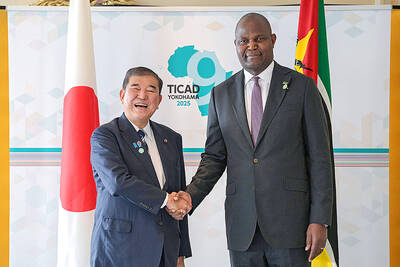Like many prostitutes who ply their trade in the darkened bars and discos near tourist hotels here, Maria says she does not go out every night. But whenever money gets tight and her 12-year-old son is hungry, she puts on a red miniskirt, puts rouge on her lips and heads for El Conejito bar, a thinly disguised rendezvous point.
"Most of the tourists come to look for girls, tobacco, you know, the things they cannot get in their country," she said. "They say the Cuban girls are very hot."

PHOTO: NY TIMES
Maria, who is 36 and insisted that her last name not be published, said she worried about contracting AIDS and forced her clients to use condoms, every time. She is knowledgeable about the disease, having learned about it through the government's anti-AIDS program, and she was tested twice during a stint in jail last year for prostitution. Since then, she said, she voluntarily gets tested regularly at the free health clinics.
A decade after an economic collapse forced thousands of young women and men into prostitution, Cuba has become something of an anomaly in Latin America: a destination for sex tourists where AIDS has yet to become an uncontrollable pandemic.
Cuba has the lowest infection rate in the Western Hemisphere, less than 0.1 percent of the population, according to the World Health Organization. The infection rate in the US is six times that in Cuba, and Cuba's rate is far below that in many neighboring countries in the Caribbean and Central America.
That is not to say the disease is not spreading in Cuba, and some outside the government say a thriving sex industry has contributed to its spread. On July 3, 1998, the Cuban government said 1,980 people had tested positive for the virus that causes AIDS since 1986. Since 1998, 3,879 more have been discovered to have the virus, according to statistics released by health officials; in just six years, the number of newer cases has nearly doubled.
"I think the epidemic has kept growing," said the Reverend Fernando de la Vega, a Roman Catholic priest who runs a program for people with AIDS at the Iglesia Montserrat in Old Havana. "We have to face facts. There is a portion of tourists, mostly Europeans, who come to Cuba for a good time, and a good time includes sexual activity."
Cuban health officials acknowledge that the number of infections has increased, as in most countries, but they say the overall rate is very low for a population of 11 million.
"Prostitution is not an aggravating problem in the epidemic," said Rigoberto Lopez, the director of the National Center for the Care of Persons with HIV-AIDS, adding that only a handful of the 280 patients he cares for at the main sanitarium for AIDS patients in Havana, known as Los Cocos, are former sex workers.
For more than a decade, the government has run an intense public-education campaign in schools and on state-owned television and radio stations, promoting the use of condoms and informing people about how HIV, the human immunodeficiency virus, is transmitted. The system of free primary care clinics in Cuba, a communist country, has also led to the early detection of the virus in many people, Cuban and UN officials say.
In the early 1990s, Cuba quarantined people with the virus, and those discovered to be infected are still required to stay three to six months in one of Cuba's 13 government AIDS sanitariums, where they receive treatment and counseling on how to survive with the virus and how to avoid passing it along. Once they leave the hospitals, the patients are closely monitored in their homes by social workers, officials say.
A decades-old US embargo on selling Cuba many medical supplies has crimped the country's ability to provide drugs to patients, but the government has replicated some advanced retroviral medicines used to fight AIDS, providing them at no cost. This, too, has slowed the epidemic.
UN officials who track AIDS say Cuba has done a better job than most countries at corralling the disease. "Certainly there has been an increase in AIDS, but it is not big, not like you see in the Dominican Republic, or Haiti, or in Puerto Rico," said Paloma Cuchi, who oversees the UN AIDS program in Latin America. "They have a very good medical infrastructure, and people have access to care and prevention."
The low levels of the virus in Cuba and the inexpensive price of sex compared with other places have made the island a destination for male tourists seeking women.
In Havana, the sex trade becomes obvious after sunset. Around 10 p.m., young women in skimpy attire begin gathering outside the main tourist hotels, asking men if they would like to go to nightclubs, where a sex-for-cash proposition is usually made.
Sex workers, known as jinateras, seeking tourist clients can also be seen outside certain discos and bars, or hitchhiking along the Malecon, the main highway separating Havana from the sea, to proposition tourists.
In interviews, several jinateras said the brutal economic conditions in Cuba under the US embargo, where monthly state salaries do not buy enough food for a month, had pushed them into the business.
Most work for themselves, and on most days, they say, they can count on US$50 to US$75 from Europeans, plus meals, drinks and gifts.
The government periodically cracks down on prostitution, they said. Undercover police officers work the streets and clubs, looking for prostitutes. An arrest can mean a two-year prison term.
But some women said they kept relationships with pimps, or chulos, to pay off the police. These men lurk outside hotels and guide tourists to bars where the women wait. One recent night, a chulo was working the fringes of the Melia Cohiba, a hotel, trying to persuade men to go to the Copa Room, a nearby disco in the Riviera Hotel.
"If you see a girl you like inside, you tell me and she can come to your room," said the man, who gave his name only as Carlos. "The hotels usually do not allow the jinateras upstairs," he added, winking. "But everything is possible with money."
For the most part, the women who work as prostitutes say they are looking to link up with someone who can take them out of Cuba, or provide them with a steady income. Many are part-time prostitutes, who go out only when their meager state salaries run out.
Hermita, 28, a secretary at a school who earns about US$8 a month, was trolling for tourists near the Hotel Inglaterra in Old Havana on a recent evening. She has a 2-year-old daughter from a marriage that did not last, and she said she needed money for food, clothing and shoes.
"When I am with a foreigner, I try to be with them for the whole time they are here," she explained. "Above all it's about the money." Ideally, however, she would "meet a foreigner, marry him and be able to travel, without having to leave the country forever."
Outside Jardinas 1830, an outdoor disco on the Malecon also known as a place to pick up jinateras, Maria A. and her sister, Yamilet, two young women from Camaguey province, were showing off their legs and midriffs to tourists who approached the club, hoping someone would invite them in for a drink or take them to a rooming house for the night.
Maria A., 23, said she gave up working as a hairdresser and started sleeping with tourists two years ago. She said she came close to striking it rich when an Italian tourist several years older than she had agreed to pay for an apartment for her. But they quarreled on a subsequent visit, she said, and now she is on the hunt again. In the meantime, she collects US$40 to US$70 a night from any tourist she can lure to a rooming house with which she has a mutually beneficial arrangement.
"Nobody does this because they like it," she said, drawing on a cigarette. "I would marry someone to get out."
Asked about AIDS, Maria shrugged. "We take care of ourselves, protect ourselves, use condoms," she said. "I get a test from the doctor every six months."

During the Metal Ages, prior to the arrival of the Dutch and Chinese, a great shift took place in indigenous material culture. Glass and agate beads, introduced after 400BC, completely replaced Taiwanese nephrite (jade) as the ornamental materials of choice, anthropologist Liu Jiun-Yu (劉俊昱) of the University of Washington wrote in a 2023 article. He added of the island’s modern indigenous peoples: “They are the descendants of prehistoric Formosans but have no nephrite-using cultures.” Moderns squint at that dynamic era of trade and cultural change through the mutually supporting lenses of later settler-colonialism and imperial power, which treated the indigenous as

By 1971, heroin and opium use among US troops fighting in Vietnam had reached epidemic proportions, with 42 percent of American servicemen saying they’d tried opioids at least once and around 20 percent claiming some level of addiction, according to the US Department of Defense. Though heroin use by US troops has been little discussed in the context of Taiwan, these and other drugs — produced in part by rogue Chinese Nationalist Party (KMT) armies then in Thailand and Myanmar — also spread to US military bases on the island, where soldiers were often stoned or high. American military policeman

An attempt to promote friendship between Japan and countries in Africa has transformed into a xenophobic row about migration after inaccurate media reports suggested the scheme would lead to a “flood of immigrants.” The controversy erupted after the Japan International Cooperation Agency, or JICA, said this month it had designated four Japanese cities as “Africa hometowns” for partner countries in Africa: Mozambique, Nigeria, Ghana and Tanzania. The program, announced at the end of an international conference on African development in Yokohama, will involve personnel exchanges and events to foster closer ties between the four regional Japanese cities — Imabari, Kisarazu, Sanjo and

A town in Japan is to urge all residents to restrict their smartphone use to two hours a day in an attempt to tackle online addiction and sleep deprivation. Officials in Toyoake, Aichi prefecture, said the measure would target not only children but also adults, amid growing concern about the physical and psychological toll excessive smartphone use is taking on people of all ages. The move aims “to prevent excessive use of devices causing physical and mental health issues … including sleep problems,” the mayor, Masafumi Koki said recently. The Toyoake municipal assembly began debating the non-binding ordinance this week ahead of a